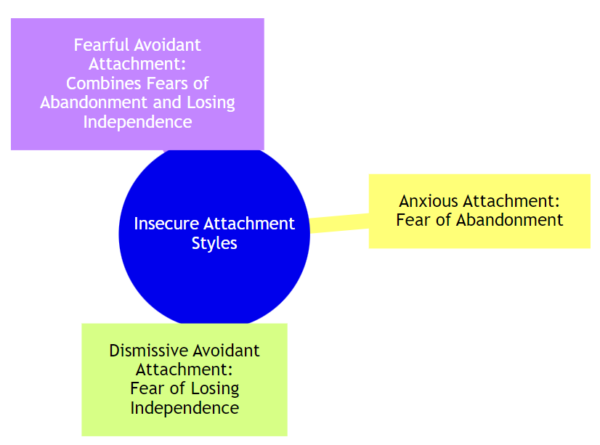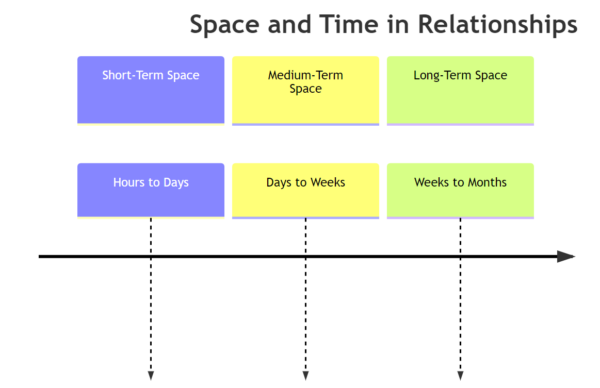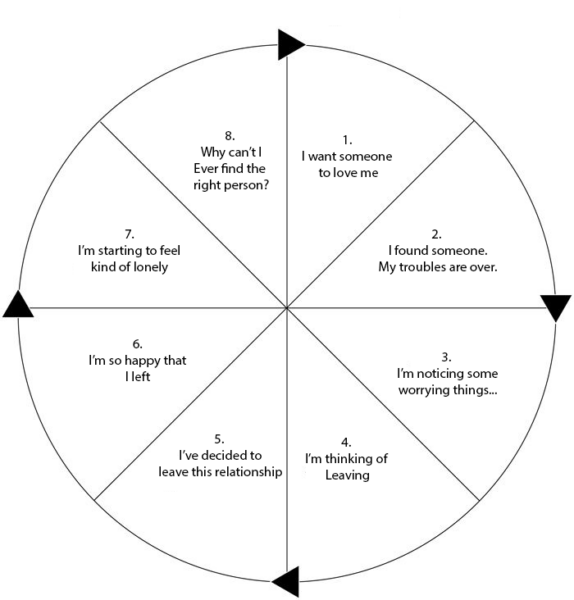Today I’d like to talk about how much space you should be giving an avoidant ex.
The reality is that there’s no universal solution that applies to everyone. Particularly in the context of past relationships, the most accurate guidance one can offer is a spectrum of possible timeframes. Based on my research, I suggest that a period of several weeks to a few months should be considered when giving your avoidant ex space after a breakup.
But I don’t want to just talk about breakups. I know this is about exes but I’d like to talk about avoidants as a whole.
In this discussion we’re going to talk about,
- Why it’s important to understand the psychology of avoidants
- How much space to give avoidants throughout all phases of a relationship
- Learning from the no contact rule with dismissive avoidants
- Why fearful avoidants are different
Let’s get started,

What Are Your Chances of Getting Your Ex Boyfriend Back?
Take the quizUnderstanding The Psychology Of Avoidants
The first thing we should always do when talking about avoidance is to understand the psychology behind it. But to do that, we need to actually understand the psychology of every single insecure attachment style, of which there are three:
- The anxious attachment style
- The dismissive avoidant attachment style
- The fearful avoidant attachment style.
The best way I’ve found to explain this concept to newbies is by breaking down the core wounds of each insecure attachment style.
Core Wound = The one thing that can set each of these attachment styles off, causing them to exhibit anxious or avoidant behaviors.
- For the anxious attachment style, it’s a fear of abandonment. Essentially, anything that makes the anxious individual feel as if they’re going to be abandoned will trigger them, and they’ll react in very anxious ways.
- For the dismissive avoidant attachment style, it’s the fear of losing their independence. The threat of potentially getting married, entering into a relationship, or taking the relationship to the next step—these are all perceived as threats to the dismissive avoidant’s independence, which ultimately leads them to start avoiding.
- The fearful avoidant has both the anxious core wound and the avoidant core wound. So one minute, they’re afraid of being abandoned, and the next minute, they feel overcrowded and as if their independence is being intruded upon. This is an extremely rare attachment style, but it has been observed before. It can feel like you’re dealing with two different people at times—one that’s incredibly hot and one that’s incredibly cold, which can be incredibly confusing.
However, it’s important to understand the difference between the fearful avoidant attachment style and the dismissive avoidant attachment styles.
Both exhibit avoidance, but they handle conflict in very different ways. I think if we’re going to talk about how much space you need to give to someone who is avoidant, it’s important to understand how much space to give to someone with dismissive avoidance and how much space to give to someone with fearful avoidance.
How Much Space Do We Give To Avoidants Exactly?
Assigning a specific timeframe for giving space to someone with anavoidant attachment style is challenging because it greatly depends on the individual’s needs, the context of the situation, and the dynamics of the relationship.
Here’s a few quick guidelines:
(In A Relationship) Short-Term Space: Hours to Days
- Cooling Off After Conflict: If there has been a conflict or intense emotional situation, a few hours to a day or two might be necessary for a dismissive avoidant individual to process their feelings independently.
- Regular Independence: On a day-to-day basis, ensuring that they have time alone to engage in personal hobbies or interests can be beneficial. This might mean a few hours each day where they are not expected to interact or communicate.
(In A Relationship) Medium-Term Space: Days to Weeks
- Processing Major Events: For more significant events or during high-stress periods, a dismissive avoidant might need a longer period, such as a week or two, to handle their emotions or to regain their sense of independence.
- Establishing Boundaries: When working on relationship boundaries, it might be helpful to have several days apart to reflect on what each person needs from the relationship.
(Broken Up) Long-Term Space: Weeks to Months
- Personal Growth: If there are personal issues or a need for self-improvement that an avoidant individual wants to address, they might require an extended period, such as a month or more. This time can be crucial for personal development and self-reflection.
It’s really that “long term space” that I want to talk about the most since this is probably going to be the most common timeframe that most of the people reading this article are going to fall into.
Diving Into Long-Term Space
Traditionally, this is an area where I have extensive experience.
One of the most popular strategies we recommend to our clients is a period of no contact.
This involves taking a break from their ex for typically 21 to 45 days, during which they don’t call, text, or respond to any communications from their ex. It’s essentially a timeout before reengaging with that person.
We’ve found that, provided you focus on your personal growth and aim to essentially ‘outgrow’ your ex during this time, the no contact rule can be highly effective in getting your ex back.
Now, there are three traditional timeframes:
- The 21-day rule, which is ideal for individuals with exes who have anxious or fearful avoidant attachment styles;
- The 30-day rule, which suits those with exes who have secure attachment styles;
- The 45-day rule, which we’ve found to be perfect for people with dismissive avoidant exes.
So, we have our first concrete timeframe for the amount of space you should give a dismissive avoidant ex after a breakup: 45 days.
The reasoning behind this is that we aim to reinitiate contact with the dismissive avoidant once they are past the separation elation phase of what we call the ‘avoidant death wheel.’
Take a look at this graphic right here.

What Are Your Chances of Getting Your Ex Boyfriend Back?
Take the quizThe avoidant death wheel consists of eight main stages, starting with the desire for love and ending with full-blown depression.
It’s during stages seven and eight—when the avoidant starts feeling lonely and enters depression—that they are most likely to reach out or respond positively to you reaching out, as they begin to romanticize the past and view you with nostalgia.
This process typically takes around 45 days. However, there’s a strong argument to be made that even longer than 45 days may be warranted.
I had the pleasure of interviewing Julia Kristina, a clinical psychologist from Canada. I asked her point-blank, ‘How long do you think the no contact rule should be?’
Here was her answer:
Julia Kristina: Okay, so I’m basing this off of science in other areas. And so I’m taking a kind of this, it sounds like a good theory, but I’m gonna say 90 days, okay, right. When you think about 90 days is the probationary period at a new job, that’s how long it takes, you know, to kind of get your handle on what’s going on in new job to start feeling settled, understand what’s happening, when it’s, you know, that hold that level of newness 90 days is what they say a lot of the time, you know, 90 days to establish a new habit in your brain, although that theory has been somewhat debunked, but you know, 90 days to break a habit 90 days to really establish a habit.
She advocates for 90 days, essentially three whole months.
This is quite a departure from what I’ve been recommending for years.
I often discuss the habit rule, which suggests it takes about 66 days to form or break a habit. So, theoretically, if you apply a no contact period of 66 days, your ex could break the habit of thinking about you, potentially allowing them to move on more quickly—especially if you’re hoping to get back together.
But dismissive avoidants are a unique case. We know they require a good deal of space, and the more time they have, the more likely they are to move past the separation elation phase.
Why Breaking The NC Rule Gives Us Insight Into How Much Space To Give Avoidants
I’m not advocating for a 90-day no contact rule, but what I am observing is that typically, when our clients are trying to get a dismissive avoidant ex back using a no contact rule—let’s say 45 days—they often break it two or three times.
Each break means starting over, so they effectively end up in a no contact period closer to 60 to 90 days anyway. So, what Julia suggests might actually hold water.
I can’t pinpoint the exact timeframe that will be perfect for you. It’s such a personal matter, influenced by a myriad of factors: the context, the individual relationship dynamics, the nature of the breakup, and whether there’s someone else involved.
But generally, the more space you give a dismissive avoidant, the better. It’s about finding that ‘Goldilocks zone’—enough space for them to start feeling nostalgic, but not so much that they completely move on.
I believe the best approach is to start with 45 days. If, at the end of that period, you feel more time is needed, then extend it another 45 days. If you decide to reach out after the initial 45 days and they respond positively, that’s a good sign. It indicates a higher likelihood of rebuilding rapport. However, if the response is negative, it might be wise to consider the 90-day period Julia Kristina mentioned.
But what about fearful avoidants? We’ve focused a lot on dismissive avoidants, but they’re not the only type of avoidant out there.
Fearful Avoidants Are A Bit Trickier:
Fearful avoidants are a bit trickier.
In my opinion, what makes fearful avoidants so challenging is that they embody both core wounds of insecure attachment styles.
They harbor the anxious core wound, fearing abandonment, and they also possess the avoidant core wound. I may have already hinted at the answer to how much space to give fearful avoidants when discussing the no contact rule timeframes.
Recall that I mentioned three timeframes we typically recommend post-breakup:
- 21-day
- 30-day
- 45-day
For the 21-day rule, I suggested it’s best for those trying to reconnect with anxious or fearful avoidants. Fearful avoidants shouldn’t be given as much space as dismissive avoidants, and there’s a clear reason why.

What Are Your Chances of Getting Your Ex Boyfriend Back?
Take the quizWe understand that the dismissive avoidant primarily fears losing their independence. The fearful avoidant, however, oscillates between fearing abandonment and fearing the loss of independence, swinging back and forth between these core wounds, which can be incredibly confusing. I’ve witnessed this firsthand, and it’s quite a spectacle.
Here’s what typically happens: If you give your fearful avoidant ex a 45-day no contact period, it might trigger their anxious attachment style. They may start reaching out during the no contact period, seeking reassurance and a sign that you still care.
If you leave them without any response, the anxious core wound driving their behavior may shift towards the avoidant core wound, and it’ll take longer for them to swing back to the anxious core wound. With each swing, they linger longer in the dismissive avoidant phase, and sometimes even in the anxious phase.
Therefore, shorter periods of no contact are preferable. This is why I advocate for 21 days. It’s manageable if they oscillate between core wounds during the no contact period, but you need to be strategic about providing reassurance.
Not full-on reassurance—I’m not suggesting you declare your desire to get back together. Rather, it’s about acknowledging their presence without solving their problems for them. That’s the approach to take with fearful avoidants.
To prevent them from getting stuck in the dismissive avoidant core wound for an extended time, it’s crucial to implement shorter no contact periods.
Give them 21 days of space before you reach out with some form of reassurance. But remember, this reassurance isn’t about pleading for them to return or fixing their issues; it’s simply about acknowledgment.



